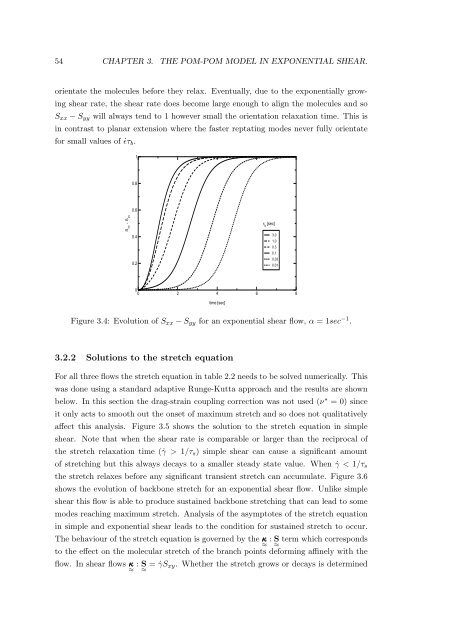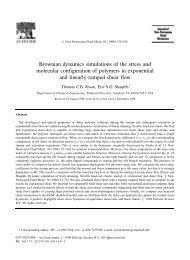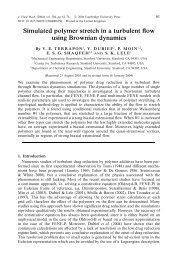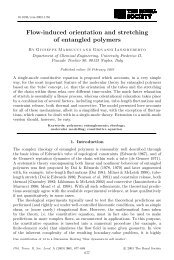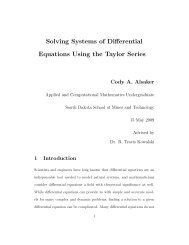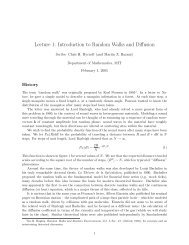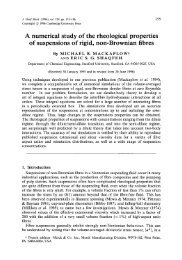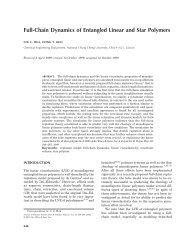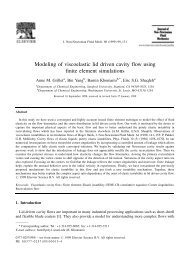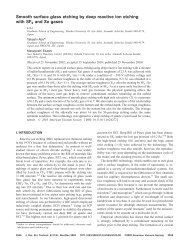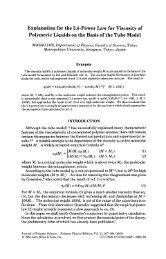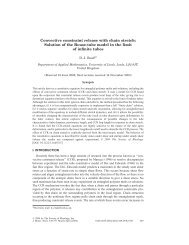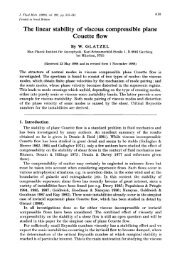Molecular modelling of entangled polymer fluids under flow The ...
Molecular modelling of entangled polymer fluids under flow The ...
Molecular modelling of entangled polymer fluids under flow The ...
Create successful ePaper yourself
Turn your PDF publications into a flip-book with our unique Google optimized e-Paper software.
54 CHAPTER 3. THE POM-POM MODEL IN EXPONENTIAL SHEAR.<br />
orientate the molecules before they relax. Eventually, due to the exponentially growing<br />
shear rate, the shear rate does become large enough to align the molecules and so<br />
S xx − S yy will always tend to 1 however small the orientation relaxation time. This is<br />
in contrast to planar extension where the faster reptating modes never fully orientate<br />
for small values <strong>of</strong> ˙ɛτ b .<br />
1<br />
0.8<br />
0.6<br />
S xx - S yy<br />
0.4<br />
0.2<br />
τ b [sec]<br />
3.0<br />
1.0<br />
0.3<br />
0.1<br />
0.03<br />
0.01<br />
0<br />
0 2 4 6 8<br />
time [sec]<br />
Figure 3.4: Evolution <strong>of</strong> S xx − S yy for an exponential shear <strong>flow</strong>, α = 1sec −1 .<br />
3.2.2 Solutions to the stretch equation<br />
For all three <strong>flow</strong>s the stretch equation in table 2.2 needs to be solved numerically. This<br />
was done using a standard adaptive Runge-Kutta approach and the results are shown<br />
below. In this section the drag-strain coupling correction was not used (ν ∗ = 0) since<br />
it only acts to smooth out the onset <strong>of</strong> maximum stretch and so does not qualitatively<br />
affect this analysis. Figure 3.5 shows the solution to the stretch equation in simple<br />
shear. Note that when the shear rate is comparable or larger than the reciprocal <strong>of</strong><br />
the stretch relaxation time ( ˙γ > 1/τ s ) simple shear can cause a significant amount<br />
<strong>of</strong> stretching but this always decays to a smaller steady state value. When ˙γ < 1/τ s<br />
the stretch relaxes before any significant transient stretch can accumulate. Figure 3.6<br />
shows the evolution <strong>of</strong> backbone stretch for an exponential shear <strong>flow</strong>. Unlike simple<br />
shear this <strong>flow</strong> is able to produce sustained backbone stretching that can lead to some<br />
modes reaching maximum stretch. Analysis <strong>of</strong> the asymptotes <strong>of</strong> the stretch equation<br />
in simple and exponential shear leads to the condition for sustained stretch to occur.<br />
<strong>The</strong> behaviour <strong>of</strong> the stretch equation is governed by the κ<br />
≈<br />
: S<br />
≈<br />
term which corresponds<br />
to the effect on the molecular stretch <strong>of</strong> the branch points deforming affinely with the<br />
<strong>flow</strong>. In shear <strong>flow</strong>s κ<br />
≈<br />
: S<br />
≈<br />
= ˙γS xy . Whether the stretch grows or decays is determined


